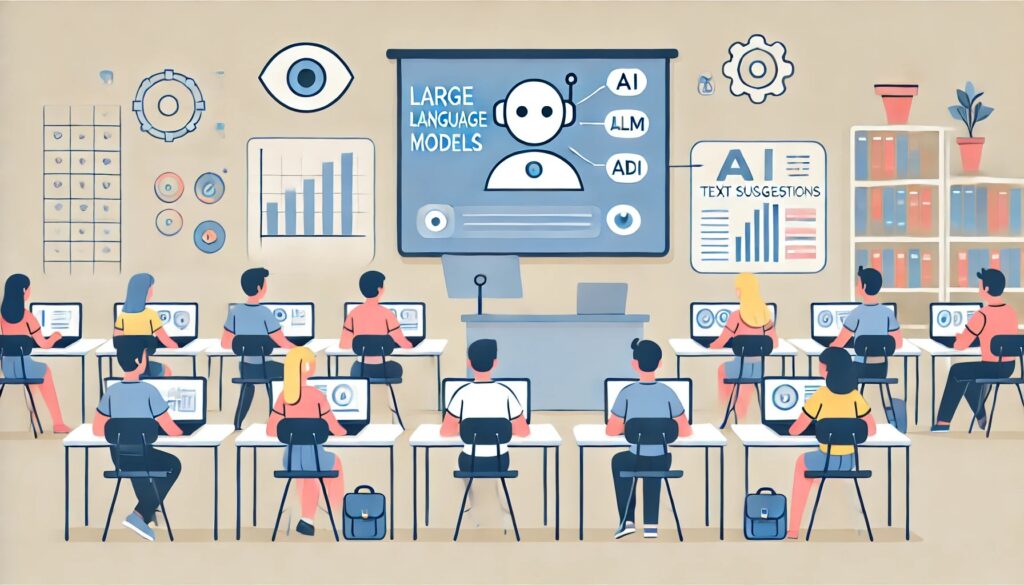ChatGPT, BERT, Claude, Cohere, and Llama are just a few examples of Large Language Models (LLMs) that utilise deep learning algorithms alongside large data sets to perform a variety of language processing tasks. The key function of these tools is to provide personalised assistance, which will ultimately lead to enhanced productivity and better performance across a wide range of sectors, including education.
The main aim of this article is to showcase real-life examples of how LLMs can be used in education. But before we dive into specific cases, it’s important to acknowledge that all LLM tools have limitations when it comes to tasks requiring complex reasoning, understanding, and knowledge, which is why their use in education remains somewhat restricted.
Student Profiling
According to a paper published earlier this year, one way LLMs can be used is to simulate student profiles. As these profiles can be tweaked to reflect various behavioural traits, learning styles, and cognitive abilities, teachers can use them to create different learning scenarios tailored to individual student needs.
In addition to obvious benefits, including better teaching and testing methods as well as improved ways to predict and address specific learning challenges, LLM-simulated student profiles provide a safe environment to test different teaching strategies, materials, and emerging technologies, like new LLM tools. With accurate data gathered through these simulations, teachers can choose to implement only the strategies and methods that deliver the best possible results.
Personalised Lesson Plans and Relevant Feedback
Today, teachers can use various LLMs to create personalised lesson plans that better align with the interests, skills, and learning goals of students, whether as individuals or organised into pairs or groups. LLMs can also automate the grading of tests and provide feedback on assignments, freeing up more time for teachers to focus on what matters most: teaching.
For instance, offering relevant and timely feedback on argumentative assignments has always been a challenge for teachers due to the sheer volume of student work and the complexity of arguments. However, a recent study found that ChatGPT can provide feedback with nearly 92% accuracy on student argumentation papers. While ChatGPT’s capability to offer relevant and accurate feedback depends on the discourse markers and length of arguments, this study demonstrates that LLMs can generate comprehensive and precise text-based feedback in most cases.
Using LLMs to analyse assignments isn’t only beneficial for teachers. Receiving feedback that is both relevant and timely can help students quickly identify areas for improvement, reinforcing their learning while the material is still fresh. This enables them to make immediate progress. Additionally, students can use LLM-based chatbots to obtain further information, such as new vocabulary terms and meanings, which can improve their language proficiency. All of this once again proves that schools can leverage LLMs to improve student support and create a more effective learning environment while promoting autonomy and competence, which are two of the most important goals of education.
Content Recommendations
In a new study, researchers provided examples of how LLMs can reduce routine workload for teachers while offering personalised content recommendations for students. In short, LLMs enable the creation of a variety of study guides that can be tailored not only to the curriculum but also to each student’s learning style and pace. These guides can be further personalised to better address specific areas on which students should focus, based on their performance.
Another case study demonstrated how these tools can be used to generate subject-specific content and adaptive guidance relevant to different learning contexts. Additionally, teachers can utilise LLMs to incorporate educational content into engaging activities, like simulations, games, and various interactive scenarios. This approach can be particularly effective for subjects that are better understood through experiential learning, such as sciences, languages, and mathematics.
Learning Analysis
With access to vast amounts of educational data, LLM tools can assess student performance and identify knowledge gaps. They can also provide valuable insights into how students engage with content, highlighting specific learning patterns and even providing predictive analytics that educators can use to support struggling students.
Although LLMs are still limited in offering contextual feedback based on detailed learning analysis, recent research has shown that the utilisation of these tools already makes assessment strategies more scalable and sustainable, ensuring better alignment with learning objectives.
Knowledge Tracing
A variety of LLMs are currently used to track students’ learning behaviour and progress. This essentially allows teachers to identify knowledge gaps more easily. As a result, they can better understand how to adapt lessons, feedback, and educational contexts to better meet students’ needs. According to a recent study, this approach will not only improve student understanding but also foster a more adaptive learning environment, promoting academic success.
Case after case has demonstrated that, even though LLMs are still relatively new, they hold incredible potential to enhance both the teaching and learning experience, while fostering greater interaction between students and teachers. Although we’re still exploring the full possibilities of LLMs in education, their current use shows great promise for transforming the entire educational system.
As we continue to analyse and understand the full potential and limitations of LLMs, it’s essential to be mindful of the challenges they bring. Teachers and students must be aware of these in order to avoid misuse. However, with proper supervision and ethical implementation, LLMs are set not only to enrich education but also to open up new possibilities for teaching and learning.




